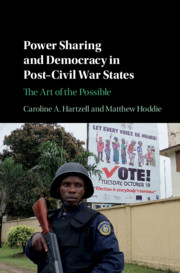Book contents
- Power Sharing and Democracy in Post–Civil War States
- Power Sharing and Democracy in Post–Civil War States
- Copyright page
- Dedication
- Contents
- Figures
- Tables
- Acknowledgments
- Part I From Civil War to Democracy – Introduction and Theory
- Part II Evidence
- 5 Power Sharing, the Transition to Minimalist Democracy, and Post-Conflict Democratization
- 6 Power Sharing and Democratization from Above
- 7 Power Sharing and Democratization from Below
- Part III Conclusion
- Appendix
- References
- Index
5 - Power Sharing, the Transition to Minimalist Democracy, and Post-Conflict Democratization
from Part II - Evidence
Published online by Cambridge University Press: 01 June 2020
- Power Sharing and Democracy in Post–Civil War States
- Power Sharing and Democracy in Post–Civil War States
- Copyright page
- Dedication
- Contents
- Figures
- Tables
- Acknowledgments
- Part I From Civil War to Democracy – Introduction and Theory
- Part II Evidence
- 5 Power Sharing, the Transition to Minimalist Democracy, and Post-Conflict Democratization
- 6 Power Sharing and Democratization from Above
- 7 Power Sharing and Democratization from Below
- Part III Conclusion
- Appendix
- References
- Index
Summary
This chapter focuses on tests of the relationship between power sharing and the transition to minimalist democracy in the aftermath of civil war. We begin by explaining the need to account empirically for the effect that difficult post-conflict environments may have on countries’ ability to make a transition to democracy. We then conduct an empirical test of our central hypothesis regarding the existence of a positive relationship between extensive power sharing and the transition to minimalist democracy in post-civil war states. Finally, seeking to respond to critics who argue that power sharing impedes the development of forms of democracy that might be considered more “aspirational” than minimalist democracy, we examine the effects that power sharing has on democratization two, five, and ten years after the end of civil war using V-Dem’s measures of electoral, liberal, and egalitarian democracy.
- Type
- Chapter
- Information
- Power Sharing and Democracy in Post-Civil War StatesThe Art of the Possible, pp. 95 - 125Publisher: Cambridge University PressPrint publication year: 2020

